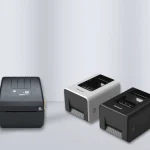Thermal label is among the labeling systems that significantly simplify business processes. Tailored to meet the specific needs of various industries, labeling solutions play a critical role in product identification and tracking across sectors. With their ability to reduce printing costs, enable fast production, and offer an eco-friendly structure, thermal labels have become widely preferred by many industries in recent years. So, what are the advantages of thermal labels and in which areas are they used?
1. What is a Thermal Label?
A thermal label is a special type of paper on which printing is done through the application of heat. This label type allows for practical printing without the need for ink, toner, or ribbon. Thermal labels are divided into two main types:
- Direct Thermal Labels: These labels produce an image using a heat-sensitive surface, without the need for ink. They are ideal for short-term and temporary labeling.
- Thermal Transfer Labels: These require a ribbon to transfer the print onto the label. They are more durable compared to direct thermal labels and are suitable for long-term use.
2. Key Advantages of Thermal Labels
Thermal labels offer a wide range of benefits for businesses, which is why they are commonly used in various sectors. Some of the key advantages include:
- Cost Efficiency: Since no ink or toner is required, operational costs are significantly reduced.
- Fast Printing: Allows for the rapid production of a large number of labels in a short time.
- Ease of Use: Thermal printers are compact and user-friendly, making them easy to operate.
- High Readability: Barcodes and texts are printed clearly and can be easily scanned.
- Eco-Friendly: Less consumption of materials makes them an environmentally conscious choice.
- Low Maintenance: With no ink drying issues, thermal printers experience fewer technical problems.
3. Application Areas of Thermal Labels
Thermal labels offer practical solutions across various industries, making them widely used in the following sectors:
- Retail: For product price tags, shelf labels, and barcodes.
- Logistics & Shipping: For cargo tracking labels and box barcodes.
- Healthcare: For patient wristbands and laboratory sample labels.
- Food Industry: For expiration dates, ingredient information, and price labels.
- Manufacturing & Warehouse Management: For inventory tracking and barcode systems.
Direct thermal labels are ideal for short-lifecycle products, especially those that are quickly consumed or subject to frequent price changes. On the other hand, thermal transfer labels are designed for more durable applications, such as outdoor storage or products exposed to high humidity and temperature.
4. Key Considerations When Choosing the Right Thermal Label
Every product and application requires the right type of thermal label. When selecting the appropriate label, consider the following:
- Expected lifespan of the label,
- Exposure to temperature and humidity,
- Compatibility with barcode scanners,
- Surface type (flat, curved, transparent, etc.),
- Quality and permanence of the adhesive.
Otherwise, issues such as fading, peeling, or unreadability may arise, leading to operational inefficiencies.
Your Trusted Labeling Partner: DGS Printing Technologies
Thermal labels are efficient labeling solutions that meet business expectations for speed, cost, and productivity. However, selecting the right thermal label and using a high-quality printing system is crucial for establishing a smooth, long-term process.
DGS Printing Technologies meets all your labeling needs with a wide range of thermal and thermal transfer labels, ribbon solutions, barcode printers, and technical support services. Known for its sector-specific solutions, DGS offers fast production, high quality, and professional consultancy tailored to your needs.
For more information and quotes: www.dgs.com.tr/en/






